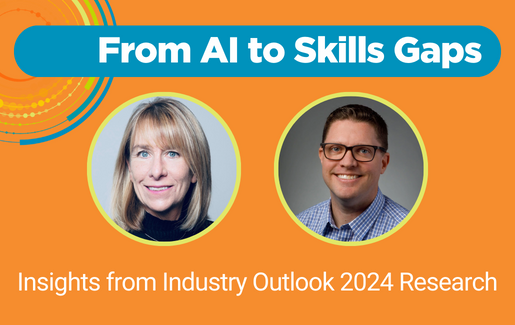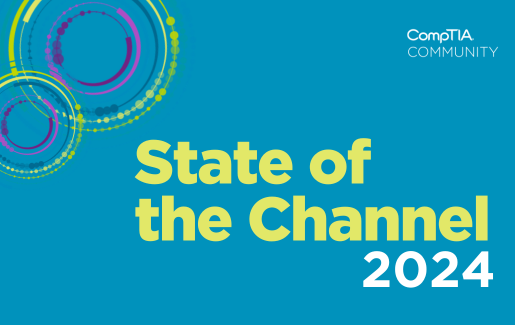 Businesses have put the pandemic behind them and are poised for growth and innovation—opening a lot of doors for MSPs and other tech organizations, according to CompTIA research executives. Companies also recognize that both tactical and strategic thinking are important components of future plans, and that tech plays a key role in their execution.
Businesses have put the pandemic behind them and are poised for growth and innovation—opening a lot of doors for MSPs and other tech organizations, according to CompTIA research executives. Companies also recognize that both tactical and strategic thinking are important components of future plans, and that tech plays a key role in their execution.
“Every business needs a foundation of both, a big business plan and in order to do that they need tactical tools and processes that enable you to achieve the strategy you’re trying to get to,” said Carolyn April, vice president of industry research at CompTIA during a fireside chat at the CompTIA Communities & Councils Forum in Chicago. “Businesses are dusting themselves off and figuring out where they want to go: AI, a greater emphasis of cyber, there’s a lot of strategic thinking for companies small and large as well as IT pros looking to take their careers to the next level—tactical things for strategic outcomes.
IT has historically been more of a tactical activity for businesses, a cost center and support function to business objectives, said Seth Robinson, CompTIA vice president of industry research, during the fireside chat hosted by Adam Proulx, senior manager of member communities at CompTIA, to discuss the CompTIA IT Industry Outlook 2024.
“That’s changed. In an organization now, the CIO function is more strategic and enabling the business to do what it needs to do,” Robinson said. “And all of you [MSPs and other tech businesses] working as a vCIO or doing that function for a client, you’re getting that pressure to be more strategic.”
Here’s a look at five trends in the research report.
Additional Research: CompTIA 2024 State of the Channel research report.
Marketing Becomes an IT Business Differentiator
Marketing can be a forgotten aspect of channel vendor relationships, but it’s incumbent upon all parties to pay more attention now, said April.
“We’ve seen an uptick in investments in marketing budgets and a likelihood to hire marketing people. Why are we seeing more progress? Out of necessity, also business model changes within the channel,” she said.
“This is another area of strategy and tactics,” added Robinson. “You could say ‘I’m going to firebomb Twitter and LinkedIn, but if you don’t know why you’re doing it, the reason behind it, there has to be questions as to why to do marketing. What outcomes are you trying to achieve?”
Tying marketing activities into sales operations is also important. “If you’re not closing the loop, you’re not closing deals,” April said. “If marketing is not working with sales reps who actually sign deals, it’s a waste of time. A lot of work has to be done between the two.”
AI Moves from Hype to Happening
The hype behind artificial intelligence for the last year-plus is starting to moderate but there’s still a lot going on that is producing real-world results, according to Robinson.
“It’s about transforming workflows and building automation. We look at these trends, and we see a hype cycle, but AI is bigger than most of them because the actual promise of the tech is huge as compared to, say blockchain,” Robinson said. “Also, momentum for AI has been building for a while, different phases of it and it will start to play into use cases. From a business perspective it is sci-fi turned into reality. Now the hype is dying down or moderating and we’re moving away from just excitement. It can do great things companies are asking what are some of the setbacks or hurdles to overcome.”
The influx of ChatGPT and other large language models has helped consumerize AI to some extent, but there’s also a lot of potential to run your business more efficiently.
“We’ve tried to use automation for some time, to free up time to do different things. When you see real true generative AI tools that the channel take to market, it will be huge. Right now, it’s more for internal use, how to run your business more efficiently. That’s important because it can also help boost profitability.”
Digital Transformation: Buzzword or Big Deal?
Digital transformation is hard to define, hard to measure and hard to compare.
“There is no ‘digital transformation solution.’ But when we talk about software-defined processes or cyber-aware processes, all those things have to come together. Companies are doing well pulling them all together, but it’s not one project. It’s not, ‘We’re kicking off our digital transformation project on Oct. 1 and it will take six months,’” Robinson said. “People want it to be a project with an end date but it’s another gradual thing. Every company has different capabilities and priorities so digital transformation efforts will look different to everybody. It's also a fairly complex thing. We’re making the solution stack deeper and more complicated. Companies are moving from a tactical product mindset to a more strategic mindset. There’s not an easy button. This is hard.”
Digital transformation projects will create big opportunities for IT services firms, added April, noting that implementing tangible metrics into the projects will help define success.
“When companies were doing big ERP or CRM projects, employees were only using 5% of their capabilities. No one was applying the right metrics. For a lot of digital transformation projects, having some practical metrics around them will be a best practice. You’re doing [customers] a favor by putting up guideposts along the way so they see a return for their money.”
Workforce Trends and Best Practices
More companies are taking a skills-based approach to their workforces, defining a very specific library of skills and talents necessary for success in each role and helping employees achieve those skills.
“When you lay out a skills trajectory for someone’s career, you’re not leaving it up to them alone. As employers, you need to be invested,” April said. “If skills-based promotion is your core to move up in an organization, it shouldn’t only be up to them to go get those skills. Your role is to provide training, tuition reimbursement, so it’s a team effort to get the skills. Help them figure out how to get there.
Career transparency is also important, added Robinson. Employees should know exactly what skills they needed to advance and be successful. We are moving away from expectations of time-based promotions,” he said. “Also, if you need a data analyst, that comes with highly technical skills, but it also requires some business skills, durable skills. So you can say here are the skills you need and we can train you for the [rest].”
Cybersecurity Governance Comes Forefront
In any organization, governance can refer to the best practices and processes that businesses follow internally, or it could mean adhering to governmental compliance and regulations. In either case, cybersecurity has become a significant component, April and Robinson said.
“We always talk about this feeling that we’re never going to catch the result. We’re always chasing in cybersecurity. Governance is one thing that will improve that. It might not be perfect or get there because threats will always be involving. But having a methodology and a framework for how to do cybersecurity will go a long way,” said Robinson.
Also, cybersecurity talent can be challenging for MSPs to hire and retain, so it behooves them to consider partnering with other firms, April said. “Turn to an MSSP and partner up. Do it as a quid pro quo. Recommend one another. It’s a good stopgap measure for our industry where you don’t have a skill. It’s a non-competitive arrangement.”

 Add CompTIA to your favorite RSS reader
Add CompTIA to your favorite RSS reader

